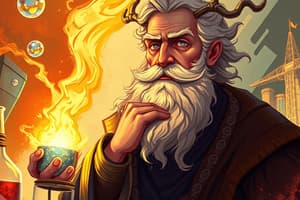Podcast
Questions and Answers
Who was the first scientist to show that the atom was made of even smaller particles?
Who was the first scientist to show that the atom was made of even smaller particles?
- John Dalton
- J.J. Thomson (correct)
- Democritus
- Eugen Goldstein
Which Greek philosopher suggested that the world was made of 'atomos'?
Which Greek philosopher suggested that the world was made of 'atomos'?
- Eugen Goldstein
- John Dalton
- Ernest Rutherford
- Democritus (correct)
What did John Dalton's Atomic Theory state about the atoms of one element?
What did John Dalton's Atomic Theory state about the atoms of one element?
- They are unbreakable.
- They are all the same. (correct)
- They are all different.
- They can be broken down into smaller parts.
Who discovered the positively charged particles known as protons?
Who discovered the positively charged particles known as protons?
Which scientist's experiment led to the discovery of the nucleus of a gold atom in 1913?
Which scientist's experiment led to the discovery of the nucleus of a gold atom in 1913?
Which scientist conducted the Oil Drop Experiment to determine the charge on an electron?
Which scientist conducted the Oil Drop Experiment to determine the charge on an electron?
What did Rutherford conclude based on the Gold Foil Experiment results?
What did Rutherford conclude based on the Gold Foil Experiment results?
What is the function of the nucleus in an atom?
What is the function of the nucleus in an atom?
What is the approximate mass of a proton or a neutron?
What is the approximate mass of a proton or a neutron?
What is the charge of an electron?
What is the charge of an electron?
What happens to an atom when it gains electrons?
What happens to an atom when it gains electrons?
Which type of change does not alter the chemical composition or identity of a substance?
Which type of change does not alter the chemical composition or identity of a substance?
Flashcards are hidden until you start studying
Study Notes
Atomic Structure
- Democritus (460 BC) proposed that the world is made of two things: empty space and "atomos" (Greek word for uncuttable).
- He believed that atoms are the smallest possible particles of matter and that there are different types of atoms for each material.
John Dalton's Atomic Theory (1804)
- All matter is made of atoms.
- Atoms of one element are all the same.
- Atoms cannot be broken down into smaller parts.
- Compounds form by combining atoms.
Dalton's Early Atomic Model
- The "Billiard Ball" model, where atoms are solid, hard spheres like billiard balls.
J.J. Thomson's Contributions
- Discovered the electron, showing that atoms are made of even smaller things.
- Used the Cathode Ray Tube to discover electrons.
Eugen Goldstein's Contributions
- Discovered canal rays, which are beams of positively charged particles, using a cathode ray tube.
- Credited with the discovery of protons in an atom.
Millikan's Oil Drop Experiment
- Determined the charge on an electron.
- Used Thomson's charge to mass ratio to calculate the mass of an electron.
Ernest Rutherford's Contributions
- Discovered the nucleus of a gold atom with the "gold foil" experiment (1913).
- Found that the atom is mostly empty space, with a small, dense center having a positive charge.
- Discovered the nucleus in atoms.
Structure of the Atom
- An atom is the smallest particle of an element that can exist alone.
- Two regions of an atom: the nucleus and the electron cloud.
- The nucleus is the center of the atom, containing protons and neutrons.
- The electron cloud is the area surrounding the nucleus, containing electrons.
Protons, Neutrons, and Electrons
- Protons have a positive charge (+), 1 atomic mass unit (amu), and are found in the nucleus.
- Neutrons have a neutral charge (0), 1 amu, and are found in the nucleus.
- Electrons have a negative charge (-), a very small mass, and are found in the electron cloud.
Counting Atoms
- Atomic number: the number of protons in the nucleus, determining the identity of the element.
- Mass number (atomic mass): the number of protons + neutrons, measured in units of g/mol.
- Isotopes: atoms of the same element with varying numbers of neutrons, having different mass numbers.
Atoms and Ions
- In a neutral atom, the number of protons equals the number of electrons, resulting in an overall charge of zero (0).
- When an atom gains or loses electrons, it forms ions, with a negative charge when gaining electrons and a positive charge when losing electrons.
Physical and Chemical Changes
- Change: the act of altering a substance, an event, not a trait.
- Physical change: does not alter the chemical composition or identity of a substance, only the form (e.g., melting ice, freezing Kool-aid).
- Chemical change: alters the chemical composition or identity of a substance.
Studying That Suits You
Use AI to generate personalized quizzes and flashcards to suit your learning preferences.




